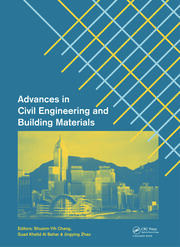The field of civil engineering is constantly evolving, driven by the need for more sustainable, resilient, and efficient infrastructure․ Recent years have witnessed a surge in innovation, particularly in the realm of building materials, leading to exciting advancements that promise to reshape our built environment․ These improvements span a wide range of areas, from enhancing the structural integrity of buildings to minimizing their environmental footprint․ The continued development of **advances in civil engineering and building materials** is crucial for creating a more sustainable and resilient future for our cities and communities, and that includes innovations like self-healing concrete․
Revolutionary Building Materials
Traditional building materials like concrete and steel are being challenged by a new generation of innovative substances․ These materials offer enhanced performance characteristics, such as increased strength, durability, and sustainability․
- Self-Healing Concrete: Incorporates bacteria or chemical capsules that release healing agents when cracks appear, significantly extending the lifespan of concrete structures․
- Transparent Aluminum: Offers exceptional strength and transparency, making it ideal for high-security windows and protective barriers․
- Aerogel: An extremely lightweight and insulating material, perfect for improving energy efficiency in buildings․
Sustainable Construction Practices
Sustainability is now a key driver in civil engineering, pushing the industry towards eco-friendly construction methods and materials․ Green building practices are becoming increasingly prevalent, aiming to minimize the environmental impact of construction projects․
Focus on Recycled Materials
Using recycled materials in construction reduces waste and conserves natural resources․ Common examples include:
- Recycled concrete aggregate (RCA)
- Reclaimed wood
- Recycled plastic lumber
Environmentally Friendly Binders
Alternative binders, such as geopolymer concrete and alkali-activated materials, are emerging as more sustainable alternatives to traditional cement․ These binders often utilize industrial byproducts, reducing carbon emissions associated with cement production․
Digitalization and Automation
The integration of digital technologies is transforming civil engineering, enabling more efficient design, construction, and maintenance of infrastructure․
Building Information Modeling (BIM)
BIM is a collaborative design and construction process that utilizes a 3D model to manage building information throughout the project lifecycle․ This allows for better coordination, clash detection, and cost control․
Robotics and Automation
Robots are increasingly being used in construction for tasks such as bricklaying, welding, and concrete pouring․ Automation improves efficiency, reduces labor costs, and enhances safety on construction sites․ The development of robotics is heavily influenced by the **advances in civil engineering and building materials** field․
The future of civil engineering is bright, with ongoing research and development pushing the boundaries of what’s possible․ We see that **advances in civil engineering and building materials** are leading to more durable, sustainable, and efficient infrastructure․ Moreover, with increased focus on sustainability we can expect to see even more eco-friendly materials and construction practices become the norm․ New strategies are constantly being created․ In the future, the integration of digital technologies and automation will further revolutionize the industry, enabling us to build smarter and more resilient cities․ As these **advances in civil engineering and building materials** continue, we’ll see a positive impact on our built environment and the planet․
Looking ahead, it’s crucial for civil engineers and construction professionals to embrace these innovations․ Staying informed about the latest materials and technologies is paramount for designing and building infrastructure that meets the demands of a rapidly changing world․ Here are a few key areas to focus on:
RECOMMENDATIONS FOR PROFESSIONALS
– Continuous Learning: Invest in professional development to stay abreast of emerging trends in building materials and construction techniques․ Attend workshops, conferences, and online courses to expand your knowledge․
– Experimentation and Pilot Projects: Don’t be afraid to experiment with new materials and technologies on a smaller scale․ Pilot projects can provide valuable insights into the performance and feasibility of innovative solutions․
– Collaboration and Knowledge Sharing: Foster collaboration between researchers, engineers, and contractors to accelerate the adoption of new technologies․ Share your experiences and lessons learned with the wider community․
– Sustainability Assessment: Prioritize sustainable construction practices by conducting thorough life cycle assessments of building materials and construction methods․ Choose materials with low environmental impact and design for durability and longevity․
– Embrace Digital Tools: Invest in BIM software and other digital tools to improve design accuracy, enhance collaboration, and streamline construction processes․ Train your team to effectively utilize these technologies․
POLICY AND REGULATORY CONSIDERATIONS
Governments and regulatory bodies play a crucial role in promoting the adoption of innovative building materials and sustainable construction practices․ Here are some recommendations for policymakers:
– Update Building Codes: Revise building codes and regulations to incorporate new materials and technologies, ensuring that they meet safety and performance standards․
– Incentivize Sustainable Construction: Offer tax incentives, grants, and other financial incentives to encourage the use of sustainable materials and construction practices․
– Support Research and Development: Invest in research and development to accelerate the development and commercialization of innovative building materials and technologies․
– Promote Green Building Standards: Encourage the adoption of green building standards such as LEED and BREEAM to promote sustainable construction practices․
– Public Awareness Campaigns: Launch public awareness campaigns to educate the public about the benefits of sustainable construction and the importance of reducing the environmental impact of the built environment․
By embracing innovation, fostering collaboration, and implementing supportive policies, we can create a more sustainable and resilient built environment for future generations․ Remember, the key to progress lies in a willingness to learn, adapt, and embrace the possibilities that new technologies and materials offer․ The future of civil engineering depends on it․







